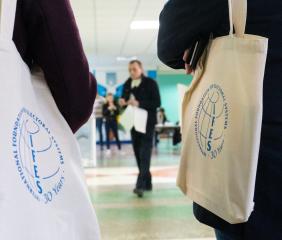
Paths to Democratic Resilience in an Era of Backsliding: A Roadmap for the Democracy Support Community
Introduction
This paper lays out a detailed approach to building democratic resilience in countries facing democratic erosion, democratic breakdown, and autocratic deepening. We define “democratic resilience” as the ability to maintain democratic governance functions and principles despite attempts by illiberal actors to damage or diminish the vertical, horizontal, or diagonal accountability mechanisms that are core to democracy. Investments in resilience may take different forms: In some cases, we may be able to help a democracy “bounce back” from episodes of backsliding; at other times, we may need to support democracy to enable it to persist in diminished form, reinforce what remains of the democratic architecture, or simply preserve the normative foundation and public demand for democracy for a future opening.
Investing in democratic resilience is increasingly essential, as autocrats — who governed 72 percent of the global population at the close of 20221 — go to ever greater lengths to preserve and expand their power. Scholarly and practitioner research continues to accumulate on the positive impacts of democracy support in a variety of contexts, including in backsliding environments.2 It is imperative that the international democracy community provide targeted, evidence-based, and coordinated long-term support to build the resilience of democratic institutions and actors.
Understanding Today’s Authoritarian Challenge
Unlike in eras past, contemporary autocrats seek not to replace democracy with a competing ideology but to manipulate the democratic system to achieve their own ends.3 While some autocrats continue to draw on traditional tools and heavy-handed oppression tactics, many also co-opt democratic rhetoric, values, procedures, and institutions in their undemocratic pursuits.4 They frequently come to power through legitimate elections.5 Once in power, they amend, reinterpret, or simply breach the law; co-opt judiciaries, election management bodies (EMBs), and other independent institutions; dissolve opposition political parties and imprison dissenters; silence the media; and incite, abet, or commit violence against women and minority groups. These actions undermine deliberation and hollow out democratic rights and processes.
In many cases, autocrats benefit from and take advantage of dysfunctional opposition: weak, undemocratic political parties and sparse or uncoordinated civil society. Facing few constraints, these leaders mine grievances, manufacture offense, and supply distorted information to their publics to further weaken calls for democracy. In lieu of crafting people-centered policies, or to distract from their own governance failures or corruption, autocratic leaders demonize vulnerable groups and fuel and spread fears that result in civic and political inaction.6 Autocrats are increasingly capable of manufacturing or exploiting growing public discontent with democracy. Global dissatisfaction with democracy has been increasing steadily since 2008,7 and the gap between expectations of democracy’s promise and the reality of what it delivers has been deepening for decades.
Autocrats also receive outside help in their pursuits. Legitimate or contrived crises, pandemics, natural disasters, inter- or intrastate conflict, and displacement or migration flows resulting from such events all offer opportunities for autocrats to gain and use emergency powers to curtail political rights and expand control over the levers of the state.8 Their efforts are further bolstered by increasing support from other powerful autocracies, such as China9 and Russia,10 which provide large investments, make highly publicized state visits, and report back favorably in state-controlled media. This autocratic cooperation — mimicking democratic cooperation, albeit to much different ends — dilutes the political pressure that the community of democracies can exert.
To meet this challenge, the democracy support community requires a practical method for identifying and classifying the many tactics of autocratization. With that common understanding, we can design interventions to foster greater resilience against affronts to democracy. Interventions in pursuit of democratic resilience — as emphasized in examples provided in this paper — should identify, center, enable, and support local democracy champions to pursue their own democratic vision and goals.
Defining Key Concepts
This section presents a practical typology for defining and understanding two core concepts: democratic backsliding and democratic resilience.
Democratic Backsliding
“Democratic backsliding” has been broadly defined as the “state-led debilitation or elimination of any of the political institutions that sustain an existing democracy.”11 This hollowing out of democratic institutions, processes, practices, and/or norms can take distinct paths across time and place. Labeling any deterioration “backsliding” with no further elaboration risks likening scenarios that are very dissimilar in style, origins, and intent. This paper takes a more nuanced approach to understanding backsliding as one of three types: democratic erosion, democratic breakdown, and autocratic deepening.12 Understanding the distinctions between these forms of backsliding can inform program design based on evidence of effectiveness in similar contexts. It is important to underscore that a country’s backsliding status is not static; countries can and do move between them — either in the direction of further autocratization as antidemocratic practices become entrenched or by “bouncing back” on the democratization path, for example, following a pivotal election.
In democratic erosion contexts, established democratic practices that ensure orderly transfers of power, accountability to the public, and related democratic values are targeted in a slow, often piecemeal, fashion. Tactics of erosion can include changes to judicial appointment procedures that ultimately weaken judicial autonomy, exerting undue pressure on civil society organizations (CSOs), or spreading misinformation about political opponents. This style of democratic backsliding is often the most difficult to identify as a true threat because it can be veiled as routine adjustments to the status quo that reflect the “will of the electorate” or other such (notably democratic) justifications. However, when not heeded, these signs of trouble can give way to entrenched anti-democratic norms — and possibly pave the way for a broader democratic breakdown. Such losses have been observed, for example, in Hungary (2010–2018),13 Ghana (since 2017),14 Brazil (2018–2022),15 and Israel (since 2022).16
Democratic breakdowns differ from erosion in several important respects. Because breakdowns tend to be rapid, multidimensional, and brazen, they are often more obvious to the casual observer. Similar tactics may be used as observed in democratic erosion but with a broader scope and/or swifter implementation, such as shutting down independent media outlets, banning the activities of CSOs or cutting off their funding streams, or deregistering opposition political parties. There may also be more severe, sudden changes, such as dissolving an entire branch of government or purging sitting officials. Breakdowns of this magnitude have been observed in Tanzania (since 2015),17 Poland (since 2016),18 Turkey (since 2017),19 Hungary (since 2018),20 El Salvador (since 2021),21 and Tunisia (since 2021).22
Finally, autocratic deepening may be observed either following long-term democratic erosion that has transformed a once-democratic regime into an autocratic one or after an acute democratic breakdown. Unlike the two previous contexts, autocratic deepening is specific to settings that would already be considered autocratic, as incumbents develop their own strategies to stay in power while further narrowing options for democratic resurgence. Such efforts may include, for example, the use of military courts to try civilians, large-scale imprisonment of journalists, or repression of the opposition in the diaspora. Drastic cases of deepening have taken place in Venezuela (especially since 2013),23 Cambodia (since 2018),24 Nicaragua (especially since 2018),25 Belarus (since 2020),26 Myanmar (since 2021),27 and Sudan (since 2021).28
In each of these cases, autocratic or would-be-autocratic leaders take specific actions that target the pillars of accountability central to a democratic system. Accountability, as used here, implies that bearers of political power assume an affirmative responsibility for their actions and must justify or answer for them — or risk being sanctioned.29 Political accountability centers on relationships between holders of power and other democratic actors, including other branches of government (horizontal accountability); citizens, often represented by political parties (vertical accountability); and media and civil society (diagonal accountability).30
Table 1 presents a non-exhaustive list of actions that are characteristic of each type of backsliding based on the accountability pillars they often target.31 These examples are non-exclusive; some actions that undemocratic leaders take could be indicative of democratic erosion or breakdown, for example, or democratic breakdown or autocratic deepening. Context and local expertise can help donors and practitioners evaluate a situation, identify the threat level, and guide program design and decision-making.
TABLE 1: Illustrative Examples of Democratic Backsliding and Associated Threats to Accountability
|
Democratic Erosion |
Democratic Breakdown Wholesale, acute decline in democratic decision-making, institutions, and civic spaces |
Autocratic Deepening Elimination of democratic space, qualities of governance, or institutions in autocratic environments |
|---|---|---|
| Horizontal Accountability | ||
|
|
|
| Vertical Accountability | ||
|
|
|
| Diagonal Accountability | ||
|
|
|
Footnotes
Papada, E., et al. (2023). “Democracy Report 2023: Defiance in the Face of Autocratization.“ University of Gothenburg: Varieties of Democracy Institute (V-Dem Institute).
Studies are also beginning to show that democracy support can have meaningful benefits in autocratic or closing spaces — even if the pathways for creating or demanding accountability are less traditional. On the need for international support, see Papada, E., et al. op. cit.; and Gamboa, L. (2023). “How Oppositions Fight Back.” Journal of Democracy 34(3): 90–104. See also Hyde, S. D., Lamb, E., & Samet, O. (2023). “Promoting Democracy Under Electoral Authoritarianism: Evidence From Cambodia.” Comparative Political Studies, 56(7), 1029–1071; Niño-Zarazúa, M., Horigoshi, A., & Gisselquist, R. M. (2022). “Aid’s Impact on Democracy.“ UNU-WIDER Working Paper Series 2022/15.
Naím, M. (2022). “The Dictator’s New Playbook: Why Democracy is Losing the Fight.“ Foreign Affairs (March/April).
Emmons, C., & Pavone, T. (2021). “The Rhetoric of Inaction: Failing to Fail Forward in the EU’s Rule of Law Crisis.” Journal of European Public Policy, 28(10): 1611–1629.
Scheppele, K. (2018). “Autocratic Legalism” University of Chicago Law Review, 85(2): 545–584.
Buril, F., Shein, E., & Vickery, C. (2023). “The Summit for Democracy Needs to Target Democracy’s Primary Adversary–And It’s Not Authoritarianism.”
Foa, R. S., Klassen, A., Slade, M., Rand, A., & Collins, R. (2020). “Global Satisfaction with Democracy 2020.” Bennett Institute for Public Policy, University of Cambridge.
See “COVID-19 and States of Emergency” Symposium in Verfassungsblog. On recommendations specific to pandemic crises, see IFES, COVID-19 Briefing Series: Preserving Independent and Accountable Institutions.
Hackenesch, C., & Bader, J. (2020). “The Struggle for Minds and Influence: The Chinese Communist Party’s Global Outreach.” International Studies Quarterly, 64(3): 723–733.
Droin, M., & Dolbaia, T. (2023). “Russia is Still Progressing in Africa. What is the Limit?” Center for Strategic & International Studies.
Bermeo, N. (2016). “On Democratic Backsliding.” Journal of Democracy 27(1): 5–19.
This assessment builds upon extensive debates in academic and practitioner literature on the conceptualization and measurement of backsliding. For a thorough overview of the concept, see Lust, E. & Waldner, D. (2015) “Unwelcome Change: Understanding, Evaluating, and Extending Theories of Democratic Backsliding.” USAID.
Bankuti, M., Scheppele, K. L., & Halmai, G. (2012). “Hungary’s Illiberal Turn: Disabling the Constitution.” Journal of Democracy 23(3): 138–46.
Ogúnmódede, C. O. (2021). “Ghana’s Recent Democratic Erosion Belies its Sterling Reputation.” World Politics Review (August 5).
Bradlow, B. H., & Kadivar, M. A. (2023). “How Brazil Can Prevent an Authoritarian Resurgence.” Foreign Affairs (January 12).
Goren, N. (2023). “Israelis’ Evolving Pushback to Democratic Erosion under Netanyahu.” Middle East Institute (January 19).
Paget, D. (2017). “Tanzania: Shrinking Space and Opposition Protest.” Journal of Democracy 28(3).
Sadurski, W. (2019) Poland’s Constitutional Breakdown. Oxford University Press; Pech, L. (2023) “7 Years Later: Poland as a Legal Black Hole.” Verfassungsblog (January 17).
Chulov, M. (2017). “Erdogan gets backing to strengthen his autocratic grip on Turkey.” The Guardian (April 16); Freedom House “Freedom in the World 2018: Turkey.”
Hungarian Helsinki Committee, Amnesty International, and the Hungarian Civil Liberties Union. (2019). “Hungary Moving Beyond Red Lines: Developments Related to the Rule of Law September 2018-January 2019.” (January 29). Freedom House “Freedom in the World 2019: Democracy in Retreat.”
Meléndez-Sánchez, M. (2021). “Latin America Erupts: Millennial Authoritarianism in El Salvador.” Journal of Democracy 32(3): 19–32.
Freedom House “Freedom in the World 2023: Tunisia.”
Corrales, J. (2023) “Venezuela’s Autocratization, 1999–2021: Variations in Temporalities, Party Systems, and Institutional Controls” in A. Fung, D. Moss, & O. A. Westad (eds.) When Democracy Breaks: Studies in Democratic Erosion and Collapse, from Ancient Athens to the Present Day. Forthcoming. Oxford University Press.
Morgenbesser, L. (2019). “Cambodia’s Transition to Hegemonic Authoritarianism” Journal of Democracy 30(1), 158–171; Bennett, C. (2022). “Cambodia 2018-2021: From Democracy to Autocracy.” Asia Maior XXXII/2021.
Muggah, R. (2023). “With Russian Support, Nicaragua Smothers Dissent.” Foreign Policy (March 9).
Maizland, L. (2022). “Myanmar’s Troubled History: Coups, Military Rule, and Ethnic Conflict.” Council on Foreign Relations (updated January 31).
Soliman, A. (2021). “Reversing the Military Coup in Sudan.” Chatham House (November 11).
While accountability structures are not the only component of a democracy, they are essential checks on power that broadly ensure government is responsive to the people’s will, maintaining a democratic society.
For more on mechanisms of democratic accountability, see Lührmann, A., Marquardt, K. L., & Mechkova, V. (2020). “Constraining Governments: New Indices of Vertical, Horizontal, and Diagonal Accountability.” American Political Science Review 114(3): 811–820.
The types of threats against horizontal and vertical accountability are derived from the Democratic Erosion Event Dataset, amended by the authors to also account for diagonal accountability.



